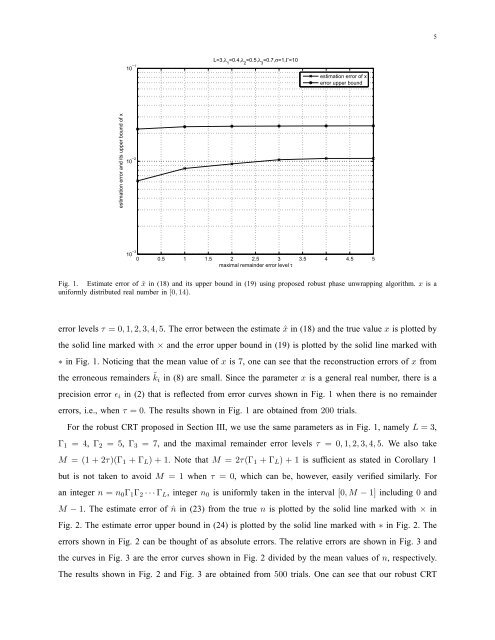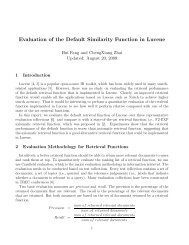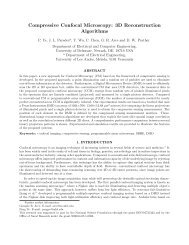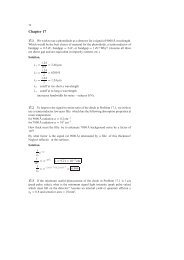Phase Unwrapping and A Robust Chinese Remainder Theorem
Phase Unwrapping and A Robust Chinese Remainder Theorem
Phase Unwrapping and A Robust Chinese Remainder Theorem
You also want an ePaper? Increase the reach of your titles
YUMPU automatically turns print PDFs into web optimized ePapers that Google loves.
5<br />
L=3,λ 1<br />
=0.4,λ 2<br />
=0.5,λ 3<br />
=0.7,σ=1,Γ=10<br />
10 −1 maximal remainder error level τ<br />
estimation error of x<br />
error upper bound<br />
estimation error <strong>and</strong> its upper bound of x<br />
10 −2<br />
10 −3<br />
0 0.5 1 1.5 2 2.5 3 3.5 4 4.5 5<br />
Fig. 1. Estimate error of ˆx in (18) <strong>and</strong> its upper bound in (19) using proposed robust phase unwrapping algorithm. x is a<br />
uniformly distributed real number in [0, 14).<br />
error levels τ = 0,1,2,3,4,5. The error between the estimate ˆx in (18) <strong>and</strong> the true value x is plotted by<br />
the solid line marked with × <strong>and</strong> the error upper bound in (19) is plotted by the solid line marked with<br />
∗ in Fig. 1. Noticing that the mean value of x is 7, one can see that the reconstruction errors of x from<br />
the erroneous remainders ˜k i in (8) are small. Since the parameter x is a general real number, there is a<br />
precision error ǫ i in (2) that is reflected from error curves shown in Fig. 1 when there is no remainder<br />
errors, i.e., when τ = 0. The results shown in Fig. 1 are obtained from 200 trials.<br />
For the robust CRT proposed in Section III, we use the same parameters as in Fig. 1, namely L = 3,<br />
Γ 1 = 4, Γ 2 = 5, Γ 3 = 7, <strong>and</strong> the maximal remainder error levels τ = 0,1,2,3,4,5. We also take<br />
M = (1 + 2τ)(Γ 1 + Γ L ) + 1. Note that M = 2τ(Γ 1 + Γ L ) + 1 is sufficient as stated in Corollary 1<br />
but is not taken to avoid M = 1 when τ = 0, which can be, however, easily verified similarly. For<br />
an integer n = n 0 Γ 1 Γ 2 · · · Γ L , integer n 0 is uniformly taken in the interval [0,M − 1] including 0 <strong>and</strong><br />
M − 1. The estimate error of ˆn in (23) from the true n is plotted by the solid line marked with × in<br />
Fig. 2. The estimate error upper bound in (24) is plotted by the solid line marked with ∗ in Fig. 2. The<br />
errors shown in Fig. 2 can be thought of as absolute errors. The relative errors are shown in Fig. 3 <strong>and</strong><br />
the curves in Fig. 3 are the error curves shown in Fig. 2 divided by the mean values of n, respectively.<br />
The results shown in Fig. 2 <strong>and</strong> Fig. 3 are obtained from 500 trials. One can see that our robust CRT











